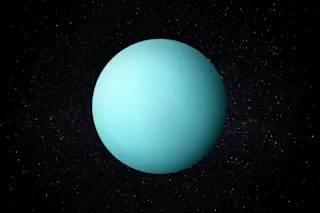As the third furthest planet from the sun (assuming you count the dwarf planet Pluto), Uranus is a ball of contradictions, hot and yet cold, placid-looking and yet churning beneath.
Scientists are still sorting out basic questions about this ice giant, including whether it has a large mantle made of “hot ice.”
Here are some facts about the pale blue planet, the first discovered in modern times.
William Herschel looks through the eyepiece as his sister, Caroline Herschel, takes notes on the night they discovered Uranus in 1781. (Paul Fouché/Wikimedia Commons)
In 1781, pioneering astronomer William Herschel first spotted Uranus using one of his self-built telescopes, but he initially mistook it for a comet or star.
He changed his mind, however, after calculating the object’s orbit, which turned out to be remarkably circular, not elliptical like a comet.
Read More: How the James Webb Space Telescope Takes Such Stunning Pictures
...














